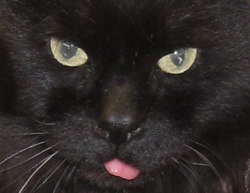Top 10 toxic plants for your pets
By Dr. Rebekah Frost - OBSERVER Columnist
“Sophie,” a three-year-old Shih Tzu came to our clinic for a visit because she had been drooling excessively, chattering her teeth, and licking her lips. On examination, her gums, tongue, and lips had the appearance of raw hamburger. After a series of questions for Sophie’s owner, we came to the conclusion that Sophie had been ingesting leaves from her owner’s Dieffenbachia plant. Any plant in the Arum family contains insoluble calcium oxalate crystals that when ingested, penetrate the oral tissues and remain in the tissue until the next skin cell cycle. Immediate signs include a painful mouth, drooling, foaming at the mouth, swallowing hard, and difficulty breathing.
In just a few weeks, I will be making my yearly trip to the local greenhouses to purchase my annual flowers and replace some of my perennials. As a pet owner, however, it is important to be aware of what plants and flowers can be toxic to our pets and try to avoid these or plant in gardens that your pet does not have access to. Below I am going to list the most common indoor and outdoor plants that can be toxic if ingested by your pet:
1. Lily family this includes the Tigerlily, Stargazing lily, Cala lily, Easter lily, Asiatic lilies, and more. Any part of these plants can cause severe kidney failure if ingested by your cat. Increased thirst and urination, dehydration, vomiting, and lack of appetite may all indicate the onset of kidney failure.
2. Autumn Crocus any part of the crocus if ingested can cause severe burning in the mouth, intense thirst, nausea, and severe vomiting and diarrhea. The bulb is the most toxic part.
3. Amyrillis family this includes Daffodils, Narcissus, Snowdrops and Amyrillus the entire plant is toxic and can cause dizziness, abdominal pain, nausea, vomiting, diarrhea, and tremors. The most toxic part of the plant is the bulb.
4. Azaleas and rhododendrons can cause oral irritation, vomiting, diarrhea, and a severe drop in blood pressure just from eating a small part of the plant.
5. Arum family as mentioned above this includes many houseplants like the Dieffenbachia, Elephants ear, and Philodendruns. They all produce calcium oxalate crystals that can build up in the gum tissues causing severe irritation.
6. Tulips and hyacinths Tulips and hyacinths are also in the lily family, but they cause different clinical signs than most lilies. Ingestion of the bulbs can cause severe nausea, vomiting, increased heart rate and increased respiratory rate
7. Cycad family this includes the Sago Palm plant and the small ornamental bonsai trees. These plants can cause severe vomiting, diarrhea, seizures, tremors, and liver failure.
 8. Glycoside containing plants these include Foxgloves, Lily of the Valley, Milkweed, and Oleander. These plants all contain cardiac glycosides similar to Digoxin, a heart medication used in human and veterinary medicine. Ingestion of one of these plants can cause severe heart arrythmias, vomiting and diarrhea, and in some cases neurologic signs.
8. Glycoside containing plants these include Foxgloves, Lily of the Valley, Milkweed, and Oleander. These plants all contain cardiac glycosides similar to Digoxin, a heart medication used in human and veterinary medicine. Ingestion of one of these plants can cause severe heart arrythmias, vomiting and diarrhea, and in some cases neurologic signs.
9. Nightshade family This family includes tomatoes, potatoes, and eggplant. Any part of the green plant can cause abdominal pain, diarrhea, delirium, headaches, and convulsions.
10. Grapes In our area grapes are abundant. Just recently it was discovered that grapes are very toxic if ingested by our pets. Grapes can cause severe kidney failure if a large amount of grapes are eaten and should be avoided at all costs!
After reading this article, please do not panic and go rip all your plants out of the ground! I highly recommend understanding your pet’s personality and monitoring them at all times. I still have a perennial garden that is all lilies because I love lilies. But my pets do not bother with the plants in the garden, and the garden is in an area away from where they spend most of their time. If you have a cat that is outdoors and likes to chew on grass and eat plants, then I would recommend NOT having a lily garden! If you have a dog that likes to dig things up and chew on their findings, then I would avoid daffodils, tulips, and crocuses that all grow from a bulb. But it is important to understand what plants may cause problems in our pets so we understand the clinical signs they might be showing and what plants to watch your pets closely with. If you ever have a question about a plant, don’t hesitate to call our clinic at 366-7440 or go www.aspca.org website for a list of toxic and non-toxic plants.
